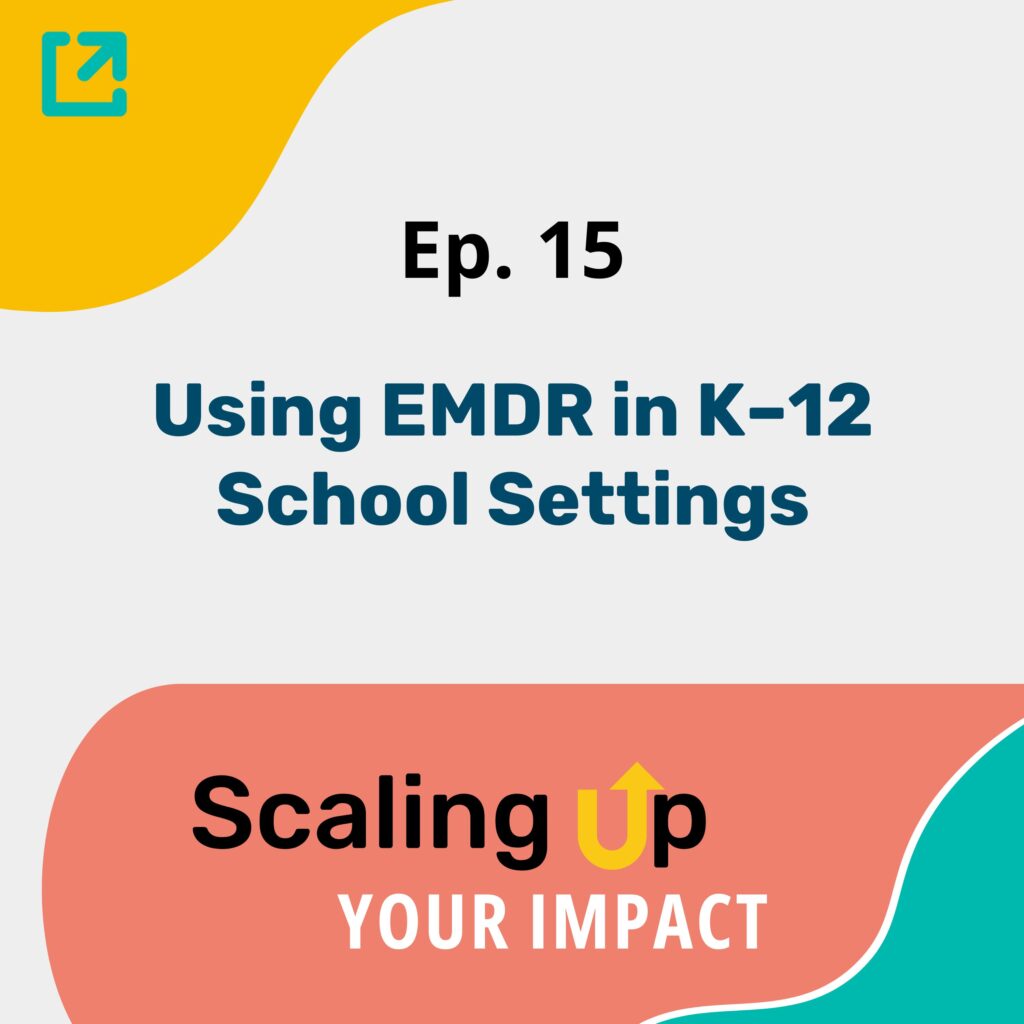Show Notes
Start with the basics. Get trained in EMDR with Scaling Up by finding your ideal cohort here: https://scalingupemdr.com/emdr-basic-training/
Level up your skills with crisis intervention and group EMDR. Sign up for our EMDR GAP Training and transform your work with students: https://scalingupemdr.com/gap-training/
Get consultation with our child-focused team members: https://scalingupemdr.com/emdr-consultants/
Transcript
Intro
Hi everyone, and welcome back to Scaling Up Your Impact, the podcast for trauma-informed therapists who want to expand their reach and create sustainable change in the communities they serve. I’m Robyn Mourning, and today we’re exploring a fascinating and important topic: How to use EMDR in K–12 school settings.
Whether you’re a school-based therapist, a community clinician partnering with schools, or just curious about how EMDR can fit into educational environments, this episode will give you practical ideas for making trauma therapy more accessible to children and adolescents right where they learn and grow.
Segment 1 – Why Schools Are Critical Spaces for EMDR
Let’s start with the why.
Schools are one of the most consistent, accessible environments for children. For many kids, especially those from marginalized or under-resourced communities, school may be the only place where they encounter a mental health professional.
We know trauma directly impacts learning—attention, memory, emotional regulation, and even physical safety cues in the brain. EMDR, with its structured, brain-based approach, can be transformative when brought into these spaces.
By offering EMDR in schools, we reduce barriers like transportation, financial cost, and stigma. And we can intervene earlier—before trauma patterns become entrenched.
Segment 2 – Clinical Considerations for Children and Teens
Using EMDR in schools isn’t just a matter of picking up the standard protocol and dropping it into a school counseling environment. Kids and adolescents need adapted approaches.
With younger children:
- Use play, drawing, and stories as part of history taking and processing.
- Shorter sessions (20–30 minutes) may work better than the traditional 50–60 minutes.
- Resourcing can be playful—think superheroes, pets, or safe places in their imagination.
- Take advanced trainings on using EMDR with kids.
- Purchase games, flashcards and other kid-centric resources for EMDR processing.
With adolescents:
- Allow for more autonomy and choice—teens may want to process specific incidents like bullying, grief, or family conflict.
- Normalize the approach—some teens may think EMDR is “weird” at first. Framing it as a way to help the brain digest memories usually lands well.
- Integration of peers and teachers: Adolescents often benefit when supportive adults reinforce regulation skills outside of therapy.
Overall:
School-based EMDR often involves more preparation and stabilization, and sometimes less intensive reprocessing. But the effects can still be profound.
Segment 3 – Logistical Realities of School Settings
Now let’s get practical—how does this actually look inside a school?
- Session Scheduling: You may only get 20–40 minutes with a student, so you’ll need to adapt the EMDR process accordingly. That might mean spreading a single target across several shorter sessions
- Environment: Schools can be noisy and chaotic. Finding a private, quiet space is essential—often a counselor’s office, resource room, or designated therapy space.
- Coordination: You’ll likely need buy-in from administrators, school psychologists, and other educational stakeholders. Clear communication about EMDR’s goals and benefits makes collaboration easier. Providing a presentation including peer-reviewed research, community benefits and educational implications may assist in achieving the integration of EMDR Therapy into your school’s counseling offerings.
- Consent and Confidentiality: For minors, parental consent is key. You’ll also need to navigate confidentiality carefully, especially when teachers are involved in referrals.
- Follow-Up: Unlike outpatient therapy, you may not have long-term access to the child. This makes group EMDR protocols—like EMDR-IGTP —particularly valuable for working with larger numbers of students after collective trauma events.
Segment 4 – EMDR in Different School Scenarios
So what does EMDR look like across different real-world school scenarios?
- After a crisis event: Following a school shooting, natural disaster, or community violence, EMDR group protocols can be implemented as a form of early intervention. These help stabilize students and reduce the risk of long-term PTSD.
- With students who have IEPs or 504 plans: EMDR can be part of broader accommodations for students with emotional or behavioral challenges. For instance, reprocessing a bullying event may reduce outbursts or avoidance in class.
- With students who have test or performance anxiety: EMDR can improve academic, athletic, club and extracurricular performance by helping students process related past adverse experiences, fears and anxieties.
- In ongoing counseling programs: For students dealing with grief, divorce, or chronic stress at home, EMDR can be integrated into their regular school counseling sessions.
- In collaboration with parents: Some schools partner with parents to reinforce resourcing skills at home, creating continuity between therapy and daily life.
Segment 5 – Barriers and How to Overcome Them
Of course, there are challenges.
- Time constraints can make reprocessing difficult. Solution: focus on stabilization and smaller targets; use group protocols.
- Skepticism from staff who aren’t familiar with EMDR. Solution: provide short in-services to explain the basics and share success stories.
- High caseloads for school-based therapists. Solution: use EMDR strategically—choose high-impact cases where processing will most reduce academic and behavioral barriers.
- Parental hesitation. Solution: use plain-language explanations about how EMDR helps the brain heal from stress, not “erase” memories.
Segment 6 – Final Thoughts & Invitation
Using EMDR in schools is about giving kids and teens the tools to reclaim their sense of safety, focus, and confidence in environments where they spend most of their waking hours.
It takes creativity, flexibility, and collaboration, but the payoff is enormous. Imagine classrooms where kids can actually learn because trauma isn’t hijacking their brains. Imagine teens who don’t have to carry overwhelming memories into adulthood because they processed them early.
If you’re curious about building these skills, Scaling Up offers trainings that cover group EMDR protocols, crisis response interventions, and adaptations for children and adolescents. We also have trainers and consultants on our team who specialize in working with school-age children, both in school and outside of school. Connect with them at the link in our show notes at scalngupemdr.com/podcast. You can learn more about all our programs at scalingupemdr.com.
Thank you for joining me today. Until next time, keep scaling up your impact—because the work you do in schools doesn’t just change one life, it can ripple across whole communities.



